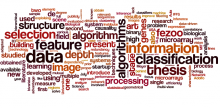BigGraph - Heterogeneous information and graph signal processing for the Big Data era. Application to high-throughput, remote sensing, multimedia and human computer interfaces.

| Type | Start | End |
|---|---|---|
| National | Jan 2014 | Dec 2017 |
| Responsible | URL |
|---|---|
| Montse Pardàs / Javier Ruiz-Hidalgo |
Reference
BIGGRAPH- TEC2013-43935-R, financed by the Spanish Ministerio de Economía y Competitividad and the European Regional Development Fund (ERDF)
Description
The aim of this project is to contribute to the progress of both the theoretical aspects of the research related to graph and tree signals and to three major application areas related to Big Data.
Graph or tree representations have the intrinsic ability of structuring the content in a scalable manner and handling heterogeneous sources of information. Therefore, they are well suited to be applied in Big Data applications where the amount of information is extremely large and the heterogeneity of the sources very often present.
The project is structured in two workpackages. The first one deals with the representation and processing of heterogeneous information and graph signals. In many cases, the original data is unstructured and based on very simple or numerous primitives (image pixels, gene expressions, etc.). This is a serious drawback for many applications and there is a current trend in the research community to define meaningful primitives and to structure them. Graphs or trees are very attractive for this task as they are formed by nodes representing meaningful and possibly heterogeneous primitives and by edges representing relations between these primitives. Specific techniques to create graphs, trees and hierarchical graphs with various edge notions will be studied for different types of data: unordered data such as microarrays or consumer data, 2D images, 3D data from multi-camera systems, and videos.
From the graph and tree structures, graph and tree signals are constructed populating them with features attached to either the vertices or the edges. Most of classical graph theory has focused on the analysis of the graph structure. In this project we want to process the signals that are defined on a graph or tree support. A major objective is to develop a full toolkit for graph signal processing, which is an emerging topic in the scientific community. The project will develop signal processing tools in the context of Graphs and Trees including convolution-based and morphological filters, frequency analysis and transform, wavelet decomposition and processing in the transformed domain, down-sampling and up-sampling, interpolation, etc. Higher-level processing tools are also of interest, in particular, segmentation and classification algorithms.
The second workpackage deals with Big Data applications, and will show how difficult issues related to Big Data applications can be handled with tools developed in WP1. There are three different areas that will be tackled. For high throughput screening experiments, such as genomics and connectomics, the major challenges are to infer the structure of the data and to demonstrate the interest of advanced processing techniques applied on graph and tree signals to extract reliable information useful for biologists or doctors. For image and video applications, such as indexing and retrieval or remote sensing, the techniques developed in WP1 will allow us to deal with the heterogeneity of the data. In the context of geometric and temporal 3D applications, characterized by the complex handling of the geometrical information and its temporal evolution, we will develop a unified approach based on graphs for human body gestures recognition and scene understanding, and we will deal with data from multi-view plus depth scenarios.
Publications
|
. Study of Gene Regulatory Networks Inference Methods from Gene Expression Data . 2017 . |
| . Snap a photo, get a recipe: pic2recipe uses AI to predict food ingredients. 2017 . |
| . Artificial intelligence suggests recipes based on food photos. 2017 ;2017. |
|
. Manifold Learning for Super Resolution . 2017 . |
|
. SalGAN: Visual Saliency Prediction with Generative Adversarial Networks. In: CVPR 2017 Scene Understanding Workshop (SUNw). CVPR 2017 Scene Understanding Workshop (SUNw). Honolulu, Hawaii, USA; 2017. |
|
. From Pixels to Sentiment: Fine-tuning CNNs for Visual Sentiment Prediction. Image and Vision Computing. 2017 . |
| . 3D Convolutional Neural Networks for Brain Tumor Segmentation: a comparison of multi-resolution architectures. In: Lecture Notes in Computer Vision. Vol. Brainlesion: Glioma, Multiple Sclerosis, Stroke and Traumatic Brain Injuries. Lecture Notes in Computer Vision. Springer; 2017. pp. 150-161. |
|
. Voxelwise nonlinear regression toolbox for neuroimage analysis: Application to aging and neurodegenerative disease modeling. In: NIPS 2016 Workshop on Machine Learning for Health. NIPS 2016 Workshop on Machine Learning for Health. ; 2016. |
|
. Temporal Activity Detection in Untrimmed Videos with Recurrent Neural Networks. In: 1st NIPS Workshop on Large Scale Computer Vision Systems 2016. 1st NIPS Workshop on Large Scale Computer Vision Systems 2016. ; 2016. |
|
. Hierarchical Object Detection with Deep Reinforcement Learning. In: Deep Reinforcement Learning Workshop, NIPS 2016. Deep Reinforcement Learning Workshop, NIPS 2016. ; 2016. |
